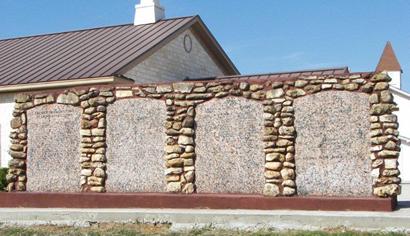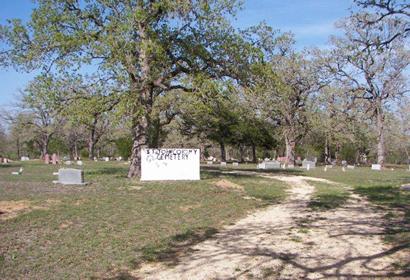St. John Colony, Texas. (original) (raw)

The St. John Landmark Baptist Church along FM 672
Photo courtesy Terry Jeanson, April 2009
History on a Pinhead
St. John Colony started with a group of Black farming families who purchased land here in the early 1870s. Since their leader was the Reverend John Henry Winn, the town was first called Winn�s Colony. After the building of St. John Missionary Baptist Church, the community was renamed. A school at St. John Colony was kept in operation through the mid 1960s.
See:
St. John Colony Landmarks St. John Historical Marker

The dilapidating St. John Zion Union Baptist Church on county road 167
Photo courtesy Terry Jeanson, April 2009

The newer St. John Regular Baptist Church with the older 1956 building on the right.
Photo courtesy Terry Jeanson, April 2009

Weathered granite tablets in front of the St. John Regular Baptist Church relating the origin and the history of St. John Colony.
Photo courtesy Terry Jeanson, April 2009.
More Texas Churches

Historical Marker
Saint John Colony
This community began in the early 1870s, when a group of freedmen and their families, let by the Rev. John Henry Winn, relocated here from Webberville (approx. 20 mi. N). The original fourteen families purchased about 2,000 acres of land to establish a town and family farms. Originally named Winn's Colony in honor of John H. Winn, the community name was changed to Saint John Colony after Winn organized Saint John Missionary Baptist Church in 1873.
The community grew steadily and at its peak included homes of about 100 families, farms, stores, a school, cotton gin, and grist mill. A post office, under the name Mackiesville, opened in 1890 with Lewis Mackey as Postmaster. Churches, in addition to Saint John Missionary Baptist, included Zion Union Missionary Baptist and Landmark Missionary Baptist. The boundaries of the colony extended into Bastrop County.
The post office was closed in the 1920s, and the school was consolidated with Lockhart schools in 1966. The churches remain active, and the community graveyard, known as Saint John Cemetery, or Zion Cemetery, contains the graves of many of the area's pioneers. Descendants of some of the founding families still reside in Saint John Colony. (1990)

Historical marker across from the cemetery
on county road 167/Chamberlin Road
Photo courtesy Terry Jeanson, April 2009
Texas Escapes, in its purpose to preserve historic, endangered and vanishing Texas, asks that anyone wishing to share their local history, stories, landmarks and recent or vintage photos, please contact us.